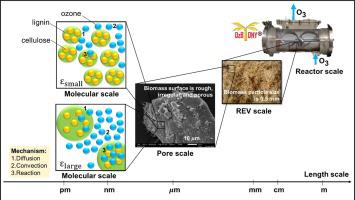Energy Conversion and Management ( IF 9.9 ) Pub Date : 2021-07-21 , DOI: 10.1016/j.enconman.2021.114526 Amnani Shamjuddin 1 , Nurul Suhada Ab Rasid 1 , Makam Mba Michele Raissa 1 , Muhammad Anif Abu Zarin 1 , Wan Nor Nadyaini Wan Omar 1 , Ardiyansyah Syahrom 2, 3 , Mohd Al Fatihhi Mohd Szali Januddi 4 , Nor Aishah Saidina Amin 1

|
Pre-treatment is the key step in biorefinery for enhancing cellulose accessibility from lignocellulosic biomass (LB) such as empty fruit bunch (EFB), which contains highly valuable cellulose. Ozonolysis pre-treatment appears as a promising green alternative for isolation of EFB to cellulose. This study develops the diffusion–reaction model of EFB ozonolysis inside a well-mixed novel OzBiONY® ozonolysis reactor at lab scale production. The mathematical model is numerically solved using COMSOL Multiphysics® software. Kinetic reaction parameters are computationally estimated via gradient-based Sparse Nonlinear Optimizer (SNOPT) method with sequential quadratic programming (SQP) algorithm. The evolution of ozone velocity and concentration profiles inside the reactor are simulated by computational fluid dynamics (CFD) method to study the effect of biomass particle sizes. The larger particle size consumes higher ozone (k1 = 2.23 m3/mol∙s) compared to the smaller particle size (k1= 0.09 m3/mol∙s). This reveals that larger biomass particle confers faster delignification rate and a much higher degradation of insoluble lignin. The simulation results demonstrate ozone velocity at the surface of larger particle is lower, but the surface concentration of ozone is higher. The diffusion–reaction model of EFB ozonolysis elucidates the plausible reaction pathway of lignin degradation via ozonolysis pre-treatment with minimum objective function (Z) of 1.41 × 10−3. From experimental results, the highest lignin degradation is 78 wt.% and the highest glucose yield is 12 wt.%. The outcomes of this research will contribute to the development of smart biorefinery technology and systems for sugar production in a sustainable and circular economy.
中文翻译:

制糖混合反应器空果串臭氧分解预处理动力学及动力学分析
预处理是生物精炼中的关键步骤,用于提高木质纤维素生物质 (LB) 如空果串 (EFB) 中纤维素的可及性,其中含有高价值的纤维素。臭氧分解预处理似乎是将 EFB 分离为纤维素的一种有前途的绿色替代方法。本研究在实验室规模生产的混合良好的新型 OzBiONY® 臭氧分解反应器内开发了 EFB 臭氧分解的扩散反应模型。数学模型使用 COMSOL Multiphysics® 软件进行数值求解。动力学反应参数通过基于梯度的稀疏非线性优化器 (SNOPT) 方法和顺序二次规划 (SQP) 算法进行计算估计。通过计算流体动力学 (CFD) 方法模拟反应器内臭氧速度和浓度分布的演变,以研究生物质颗粒大小的影响。较大的粒径消耗较高的臭氧(k 1 = 2.23 m 3 /mol∙s) 与较小的粒径 ( k 1= 0.09 m 3 /mol∙s) 相比。这表明较大的生物质颗粒赋予更快的脱木质素速率和更高的不溶性木质素降解。模拟结果表明,较大颗粒表面的臭氧速度较低,但臭氧表面浓度较高。EFB 臭氧分解的扩散反应模型阐明了通过臭氧分解预处理木质素降解的合理反应途径,最小目标函数 (Z) 为 1.41 × 10 -3. 从实验结果来看,最高的木质素降解率为 78 wt.%,最高的葡萄糖产量为 12 wt.%。这项研究的成果将有助于在可持续和循环经济中开发用于糖生产的智能生物精炼技术和系统。











































 京公网安备 11010802027423号
京公网安备 11010802027423号